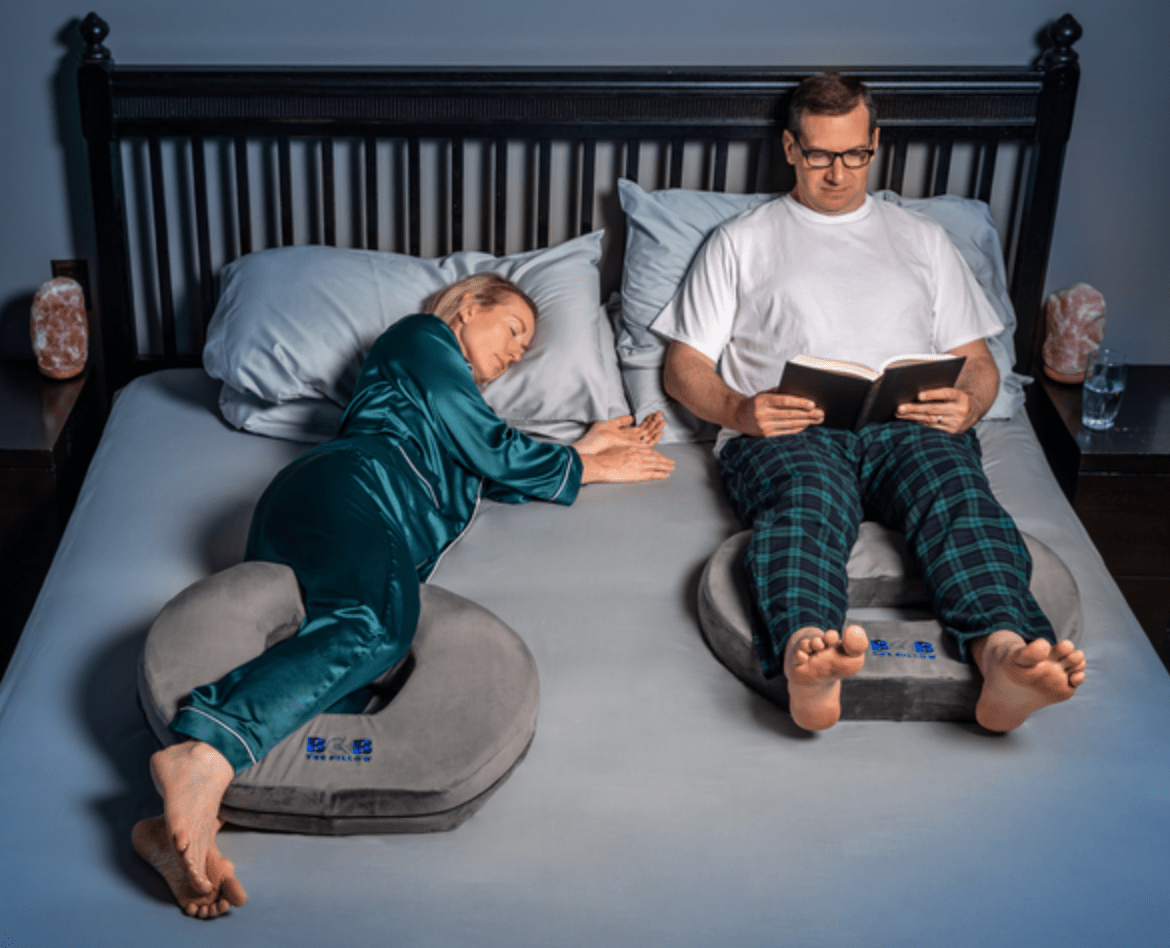Lifestyle
From Disgruntled Consumer to Disruptive Inventor

They say “necessity is the mother of invention.” In Matthew Burwick’s case, the adage holds true.
Buwick’s creative process for developing Bob the Pillow was not enjoyable. Chronic pain coursing through his entire body and exhausting nights spent in poor sleep were the needs that prompted his transformation from consumer to inventor.
Spurring invention from a half-solved problem
When Burwick was six years old, a close neighbor was first to notice his limp. After extensive x-rays and several misdiagnoses, his family learned he had a condition called Legg Perthes disease.
Burwick spent six months in a full-body cast and emerged with a functional hip. Unfortunately, his legs were mismatched by about an inch in height. That minor discrepancy led to years of pounding on the joint.
“First, I felt knee pain,” recalls Burwick. “Heel and foot pain came next. Eventually, the pain spread to my shoulders, neck, and back. I was a 20-something trapped in a 90-year-old’s body.”
Burwick embarked on an orthopedic health journey, including heel lifts, chiropractor visits, low-intensity exercises, and various surgeons. At one point, his chiropractor mentioned the benefits of sleeping with a pillow between his legs.
After research, Burwick bought his first leg pillow. “I was thrilled to see my pain decrease,” he remembers, “but I wasn’t completely satisfied with that pillow. I tried another, then another, but each one fell short in some way from being the solution I needed.”
Turning the quest for a solution into a concrete product
Roughly 20 leg pillows later, Burwick remained convinced a solution was out there, but was unable to find it. A particularly rough week of sleep combined with the global lockdown was the perfect storm that transformed a frustrated consumer into a full-fledged entrepreneur.
“My latest pillow would not stay in place during the night,” Burwick remembers. “I woke up on my stomach at all hours. Every morning, I got out of bed in worse pain than the day before.”
Burwick phoned his friend and future business partner and within hours, the pair was in a garage with furniture foam from a local fabric store and a hot glue gun. The first iterations of Bob the Pillow were laughable, but the goal was clear: make a pillow that would stay in place and keep people on their sides.
“We took pictures, sketched ideas, and found a CAD designer to bring our concept to life,” says Burwick. “Believe it or not, in under four months, we had a 3D-printed prototype for the inside of the pillow and sourced a seamstress in China capable of creating the complicated pillowcase. It wasn’t long before we had working samples.”
Understanding the process of invention
Aside from invention and product creation, innovation entails plowing through a mountain of mundane tasks. Burwick contacted a patent attorney, wrote a formal patent application, created a website, designed a logo, filed for trademarks, reviewed logistics companies, and established working relationships with importers who could ship Bob the Pillow from China to the warehouse. He coordinated all of these tiny tasks during a global pandemic and supply chain crisis.
“All of the jobs like design, legal, taxes, insurance, production, and shipping take an insane amount of time,” Burwick warns. “It’s easy to overlook details you find less exciting, but that is bound to bring trouble down the road.”
The final phase of invention involved spreading the word. Burwick chose to launch slowly and collect feedback as he went. “Strategic conversations with consumers early on gave us time to address customer input and make improvements as we grew,” he says. “Once you know there is a real need for the solution you are bringing to the market, all you have to do is educate yourself and push forward.”
Burwick’s motivation throughout the process of innovation and entrepreneurship sprang from a desire to get his pillow to people with chronic pain and sleepless nights. Today, he is thrilled every time he hears that a customer wakes up feeling better.
“Remember that just because a solution is available doesn’t mean the problem is solved,” Burwick advises. “Your idea may be just the solution for a problem that is only halfway solved. Our greatest joy is speaking to people who benefit from Bob the Pillow. My mission is to put our product into the hands of anyone dealing with long-lasting pain and give them the healing gift of sleep.”
Lifestyle
Powerful Corporate Gifting Strategies to Build and Strengthen Business Partnerships

If you want to build and strengthen business partnerships with your clients and top investors, there are a few key steps you must take. One essential strategy is corporate gifting. This simple act goes beyond building a partnership. It will also increase your customer retention rate and promote your business even beyond the shore of your country.
But before you consider gifting any item, there are some strategies to put in place. This will ensure your gift makes a lasting impression and resonates well with your clients. Below are powerful corporate gifting strategies to build and strengthen business partnerships with your clients and top investors.
Choose a Personalized Item
Rather than choosing an ordinary gift for your clients and investors, opt for a personalized item. Customised corporate gifts such as T-shirts, coffee mugs, and bags create a stronger emotional connection than generic gifts. They also leave a more lasting impression than most other gift types.
Imagine how investors and your clients will feel when you beautifully inscribe their image or favorite quotes on a T-shirt. Of course, they will feel valued, appreciated, and ready to invest more in your business.
Consider Their Culture and Background
As an entrepreneur, it’s essential to be culturally competent and sensitive. Your gifts should resonate with your clients’ and investors’ cultural backgrounds. Otherwise, they may be quickly discarded or overlooked. If your investors and audience are predominantly of Black heritage, consider giving them a custom T-shirt featuring a map of Africa or inspirational quotes from iconic Black leaders.
Their religious beliefs are also important. Specific religions may find some images or symbols inappropriate. For instance, if you’re giving a gift to a Muslim investor, avoid designs that include images like pigs, as they are considered offensive in Islamic culture.
Consider a Functional Gift
You should also consider the gift’s functionality. A gift that can be used every day will be more valuable than an impractical one. Even if the gift is expensive but doesn’t have any functional purpose, it won’t serve the purpose it was intended for.
Instead of purely sentimental keepsakes or abstract gifts, consider practical items like pens, notebooks, backpacks, coffee mugs, umbrellas, or water bottles. Just make sure the gift is well-designed and features your brand logo and identity. This not only increases brand visibility but also helps strengthen the connection between you and your investors.
Tie it to a story
Tie your gifts to a story to make them more memorable and emotionally meaningful. For example, if during your business’s early days, your employees always worked tirelessly day and night, you could opt for a custom hourglass. Clients and investors who receive such a gift will appreciate your business’s journey of patience and perseverance.
Offer Quality Gifts
Gifts given to investors or clients who have significantly contributed to your business growth should reflect their value. They shouldn’t be cheap or low-grade items. The gift doesn’t have to be trendy or widely popular, but it should come from a reputable and high-end brand. This will give your gift more credibility. Besides, the recipients will feel comfortable to use the gift among their colleagues.
-

 Tech4 years ago
Tech4 years agoEffuel Reviews (2021) – Effuel ECO OBD2 Saves Fuel, and Reduce Gas Cost? Effuel Customer Reviews
-

 Tech6 years ago
Tech6 years agoBosch Power Tools India Launches ‘Cordless Matlab Bosch’ Campaign to Demonstrate the Power of Cordless
-

 Lifestyle6 years ago
Lifestyle6 years agoCatholic Cases App brings Church’s Moral Teachings to Androids and iPhones
-

 Lifestyle4 years ago
Lifestyle4 years agoEast Side Hype x Billionaire Boys Club. Hottest New Streetwear Releases in Utah.
-

 Tech6 years ago
Tech6 years agoCloud Buyers & Investors to Profit in the Future
-

 Lifestyle5 years ago
Lifestyle5 years agoThe Midas of Cosmetic Dermatology: Dr. Simon Ourian
-

 Health6 years ago
Health6 years agoCBDistillery Review: Is it a scam?
-

 Entertainment6 years ago
Entertainment6 years agoAvengers Endgame now Available on 123Movies for Download & Streaming for Free
